How Urban–Rural Integration Symbiosis Can Ameliorate the Socioeconomic Inequity in Ecological Space: Evidence from Yunnan, China
Abstract
1. Introduction
2. Materials and Methods
2.1. Study Area
2.2. Research Methods
2.2.1. Evolution Index System of Urban–Rural Integration Symbiotic System Based on Population–Industry–Land (PIL) Interaction in Yunnan Province
2.2.2. Comprehensive Multi-Perspective Analysis of Inequity in Ecological Space (IES) Under Population-Industry Development (PO-IN)
- (1)
- Temporal unfairness research: Gini coefficient and Lorenz curve
- (2)
- Spatial difference research: Theil index
- (3)
- Dynamic change in mismatch research: Gravity-center migration model
2.2.3. The Effect of URI on IES Under Socioeconomic Development: The Two-Way Fixed Effect Model
2.3. Data Sources
3. Results
3.1. Analysis of URI Based on PIL in Yunnan Province
3.2. Temporal Unfairness of Ecological Space (ES) with Consideration of Population-Industry Development (PO-IN)
3.3. Spatial Differences in ES with Consideration of PO-IN
3.4. Dynamic Change in Mismatch Between ES and PO-IN
3.5. Analysis of the Impact of URI on IES Under Socioeconomic Development
3.6. Analysis of Heterogeneity
4. Conclusions and Discussion
Author Contributions
Funding
Institutional Review Board Statement
Informed Consent Statement
Data Availability Statement
Conflicts of Interest
References
- Zeng, Q.; Chen, X. Identification of urban-rural integration types in China—An unsupervised machine learning approach. China Agric. Econ. Rev. 2023, 15, 400–415. [Google Scholar]
- Yunnan Provincial Government. Main Data of the Third National Land Survey of Yunnan Province. Available online: https://www.yn.gov.cn/ywdt/bmdt/202112/t20211222_231960.html (accessed on 9 March 2025).
- Shen, W.; Zhang, J.; Zhou, X.; Li, S.; Geng, X. How to Perceive the Trade-Off of Economic and Ecological Intensity of Land Use in a City? A Functional Zones-Based Case Study of Tangshan, China. Land 2021, 10, 551. [Google Scholar] [CrossRef]
- Eickhouta, B.; Van Meijl, H.; Tabeau, A.; Van Rheenen, T. Economic and ecological consequences of four European land use scenarios. Land Use Policy 2007, 24, 562–575. [Google Scholar]
- Liu, H.; Chen, W.; Sun, S.; Yu, J.; Zhang, Y.; Ye, C. Revisiting China’s Urban Transition from the Perspective of Urbanisation: A Critical Review and Analysis. Sustainability 2024, 16, 4122. [Google Scholar] [CrossRef]
- Chen, M.; Gong, Y.; Lu, D.; Ye, C. Build a people-oriented urbanization: China’s new-type urbanization dream and Anhui model. Land Use Pol. 2019, 80, 1–9. [Google Scholar]
- Yang, Y.; Bao, W.; Wang, Y.; Liu, Y. Measurement of urban-rural integration level and its spatial differentiation in China in the new century. Habitat Int. 2021, 117, 102420. [Google Scholar]
- Rao, C.; Gao, Y. Evaluation Mechanism Design for the Development Level of Urban-Rural Integration Based on an Improved TOPSIS Method. Mathematics 2022, 10, 380. [Google Scholar] [CrossRef]
- Delgado-Vinas, C.; Gomez-Moreno, M.-L. The Interaction between Urban and Rural Areas: An Updated Paradigmatic. Methodological and Bibliographic Review. Land 2022, 11, 1298. [Google Scholar] [CrossRef]
- Tacoli, C. The links between urban and rural development. Environ. Urban. 2003, 15, 3–12. [Google Scholar]
- Champion, T.; Hugo, G. Introduction: Moving Beyond the Urban–Rural Dichotomy; Ashgate Publishing Limited: Surrey, UK, 2004; pp. 3–24. [Google Scholar]
- Kūle, L. Urban–Rural Interactions in Latvian Changing Policy and Practice Context. Eur. Plan. Stud. 2014, 22, 758–774. [Google Scholar]
- Ma, L.; Liu, S.; Fang, F.; Che, X.; Chen, M. Evaluation of urban-rural difference and integration based on quality of life. Sustain. Cities Soc. 2020, 54, 101877. [Google Scholar]
- Zhang, N.; Yao, Y.; Wang, L.; Li, Q. Spatial-Temporal Coupling Analysis of Land Use Function and Urban-Rural Integration in Heilongjiang, China. Land 2023, 12, 2152. [Google Scholar] [CrossRef]
- Douglass, M. A regional network strategy for reciprocal rural-urban linkages—An agenda for policy research with reference to Indonesia. Third World Plan. Rev. 1998, 20, 1. [Google Scholar]
- Zhou, J.N.; Bi, X.H.; Zou, W. Driving mechanism of urban-rural integration in Huaihai Economic Zone: Based on the space of flow. J. Nat. Resour. 2020, 35, 1881–1896. [Google Scholar]
- Paracer, S.; Ahmadjian, V. Symbiosis: An Introduction to Biological Associations; Oxford University Press: Oxford, UK, 2002. [Google Scholar]
- Tian, Y. Mutualistic Pattern of Intra-Urban Agglomeration and Impact Analysis: A Case Study of 11 Urban Agglomerations of Mainland China. ISPRS Int. J. Geo-Inf. 2020, 9, 565. [Google Scholar] [CrossRef]
- Su, Y.; Yan, Y.; Liu, C. Symbiosis Evolution of Regional Knowledge Innovation Ecosystem: The Relevance of Lotka-Volterra Model. Sci. Technol. Soc. 2024, 29, 373–396. [Google Scholar]
- Wang, J.; Meng, F.; Dong, L.; Yu, S.; Zhang, Y. A Comparative Study on the Identification Methods of Urban-Rural Integration Zones from the Perspective of Symbiosis Theory and Urban Expansion Theory. Land 2023, 12, 1272. [Google Scholar] [CrossRef]
- Smith, G.; Archer, R.; Nandwani, D.; Li, J. Impacts of Urbanization: Diversity and the Symbiotic Relationships of Rural, Urban, and Spaces in-Between. Int. J. Sustain. Dev. World Ecol. 2018, 25, 276–289. [Google Scholar]
- Griffin, T.L.C.; Smailes, P.J.; Argent, N.M. Shaping the Rural-Urban Symbiosis: Density, Dispersal, Remoteness, and Town Size in South-East Australia. Growth Change 2012, 43, 198–227. [Google Scholar]
- Wang, C.; Huang, B.; Deng, C.; Wan, Q.; Zhang, L.; Fei, Z.; Li, H. Rural Settlement Restructuring Based on Analysis of the Peasant Household Symbiotic System at Village Level: A Case Study of Fengsi Village in Chongqing, China. J. Rural. Stud. 2016, 47, 485–495. [Google Scholar] [CrossRef]
- Xiao, L.; He, Z.; Wang, Y.; Guo, Q. Understanding Urban-Rural Linkages from an Ecological Perspective. Int. J. Sustain. Dev. World Ecol. 2017, 24, 37–43. [Google Scholar] [CrossRef]
- Zhou, L.; Tu, W.; Li, Q.; Guan, D. A Heterogeneous Streaming Vehicle Data Access Model for Diverse IoT Sensor Monitoring Network Management. IEEE Internet Things J. 2024, 11, 26929–26943. [Google Scholar] [CrossRef]
- Lin, T.; Grimm, N.B. Comparative study of urban ecology development in the U.S. and China: Opportunity and Challenge. Urban Ecosyst. 2015, 18, 599–611. [Google Scholar]
- Zhou, L.; Zhao, Z.; He, Q.; Du, J.; Mu, F.; Ma, W.; Guan, D.; Zhang, X. RMCVI: A Refined Urban Vitality Perception Index Considering Mountain Characteristics. Trans. GIS 2025, 29, e13292. [Google Scholar] [CrossRef]
- Wang, X.; Wang, D.; Lu, J.; Gao, W.; Jin, X. Identifying and Tracking the Urban-Rural Fringe Evolution in the Urban-Rural Transformation Period: Evidence from a Rapidly Urbanized Rust Belt City in China. Ecol. Indic. 2023, 146, 109856. [Google Scholar]
- He, Q.; Zhou, L.; Zhang, F.; Guan, D.; Zhang, X. Efficient and Accurate Leakage Points Detection in Gas Pipeline Using Reinforcement Learning-Based Optimization. IEEE Sens. J. 2024, 24, 27640–27652. [Google Scholar] [CrossRef]
- Du, X.; Meng, Y.R.; Fang, C.L.; Li, C. Spatio-temporal characteristics of coupling coordination development between urbanization and eco-environment in Shandong Peninsula urban agglomeration. Acta Ecol. Sin. 2020, 40, 5546–5559. [Google Scholar]
- Gai, M.; Wang, Y.F.; Ma, G.D.; Hao, H.J. Evaluation of the Coupling Coordination Development between Water Use Efficiency and Economy in Liaoning Coastal Economic Belt. J. Nat. Resour. 2013, 28, 2081–2094. [Google Scholar]
- Li, X.; Ma, X.; Hu, Z.; Li, S. Investigation of urban green space equity at the city level and relevant strategies for improving the provisioning in China. Land Use Policy 2021, 101, 105144. [Google Scholar]
- Shi, J.; Li, S.; Liu, M.; Li, X.; Yan, H.; Dong, C. Ecological well-being and its equity in various economic contexts: Evidence from 130 cities in the yangtze river economic belt. Ecol. Indic. 2023, 156, 111093. [Google Scholar]
- Lu, Y.; Chen, R.; Chen, B.; Chen, B. Inclusive green environment for all? An investigation of spatial access equity of urban green space and associated socioeconomic drivers in China. Landsc. Urban Plan. 2024, 241, 104926. [Google Scholar]
- He, S.W.; Shao, X. Spatial clustering and coupling coordination of population-land-economic urbanization in Beijing-Tianjin-Hebei Region. Econ. Geogr. 2018, 38, 95–102. [Google Scholar]
- Huang, L.; Yang, P.; Zhang, B.; Hu, W. Spatio-Temporal Coupling Characteristics and the Driving Mechanism of Population-Land-Industry Urbanization in the Yangtze River Economic Belt. Land 2021, 10, 400. [Google Scholar] [CrossRef]
- Shan, L.; Jiang, Y.; Liu, C.; Zhang, J.; Zhang, G.; Cui, X. Conflict or Coordination? Spatiotemporal Coupling of Urban Population-Land Spatial Patterns and Ecological Efficiency. Front. Public Health 2022, 10, 890175. [Google Scholar] [CrossRef]
- National Bureau of Statistics of China. The Statistical Yearbook of Yunnan Province (SYY) 2022; China Statistics Press: Beijing, China, 2023. [Google Scholar]
- National Bureau of Statistics of China. The Statistical Yearbook of Yunnan Province (SYY) 2014; China Statistics Press: Beijing, China, 2015. [Google Scholar]
- National Bureau of Statistics of China. The Statistical Yearbook of Yunnan Province (SYY) 2015; China Statistics Press: Beijing, China, 2016. [Google Scholar]
- National Bureau of Statistics of China. The Statistical Yearbook of Yunnan Province (SYY) 2016; China Statistics Press: Beijing, China, 2017. [Google Scholar]
- National Bureau of Statistics of China. The Statistical Yearbook of Yunnan Province (SYY) 2017; China Statistics Press: Beijing, China, 2018. [Google Scholar]
- National Bureau of Statistics of China. The Statistical Yearbook of Yunnan Province (SYY) 2018; China Statistics Press: Beijing, China, 2019. [Google Scholar]
- National Bureau of Statistics of China. The Statistical Yearbook of Yunnan Province (SYY) 2019; China Statistics Press: Beijing, China, 2020. [Google Scholar]
- National Bureau of Statistics of China. The Statistical Yearbook of Yunnan Province (SYY) 2020; China Statistics Press: Beijing, China, 2021. [Google Scholar]
- National Bureau of Statistics of China. The Statistical Yearbook of Yunnan Province (SYY) 2021; China Statistics Press: Beijing, China, 2022. [Google Scholar]
- Li, C.; Lin, S.; Wang, Y.; Chen, L. Evaluation of regional integration in urban agglomeration area from the perspective of urban symbiosis. Sustain. Cities Soc. 2024, 105, 105338. [Google Scholar]
- Dong, L.; Zhang, H.; Fujita, T.; Ohnishi, S.; Li, H.; Fujii, M.; Dong, H. Environmental and Economic Gains of Industrial Symbiosis for Chinese Iron/Steel Industry: Kawasaki’s Experience and Practice in Liuzhou and Jinan. J. Clean. Prod. 2013, 59, 226–238. [Google Scholar] [CrossRef]
- Jiao, W.; Boons, F. Toward a Research Agenda for Policy Intervention and Facilitation to Enhance Industrial Symbiosis Based on a Comprehensive Literature Review. J. Clean. Prod. 2014, 67, 14–25. [Google Scholar] [CrossRef]
- Omacini, M.; Semmartin, M.; Pérez, L.I.; Gundel, P.E. Grass—Endophyte Symbiosis: A Neglected Aboveground Interaction with Multiple Belowground Consequences. Appl. Soil Ecol. 2012, 61, 273–279. [Google Scholar] [CrossRef]
- Huang, M.; Wang, Z.; Chen, T. Analysis on the Theory and Practice of Industrial Symbiosis Based on Bibliometrics and Social Network Analysis. J. Clean. Prod. 2019, 213, 956–967. [Google Scholar] [CrossRef]
- Chertow, M.; Ehrenfeld, J. Organizing Self-Organizing Systems. J. Ind. Ecol. 2012, 16, 13–27. [Google Scholar] [CrossRef]
- Wu, L.; Kim, S.K. Does socioeconomic development lead to more equal distribution of green space? Evidence from Chinese cities. Sci. Total Environ. 2021, 757, 143780. [Google Scholar] [PubMed]
- Chen, X.; Li, F.; Li, X.; Hu, Y.; Hu, P. Quantifying the demographic distribution characteristics of ecological space quality to achieve urban agglomeration sustainability. Environ. Res. Lett. 2021, 16, 094025. [Google Scholar]
- Ren, F.; Chen, L.; Li, T.; Li, M. Spatial Changes of Suburban Forest Ecological Functions and Their Impact on Ecological Equity in the Process of Urbanization-A Case Study of Jiangning District, Nanjing, China. Forests 2023, 14, 1308. [Google Scholar] [CrossRef]
- Koo, B.W.; Boyd, N.; Guhathakurta, S.; Botchwey, N. Environmental Equity and Spatiotemporal Patterns of Urban Tree Canopy in Atlanta. J. Plan. Educ. Res. 2023, 43, 166–181. [Google Scholar]
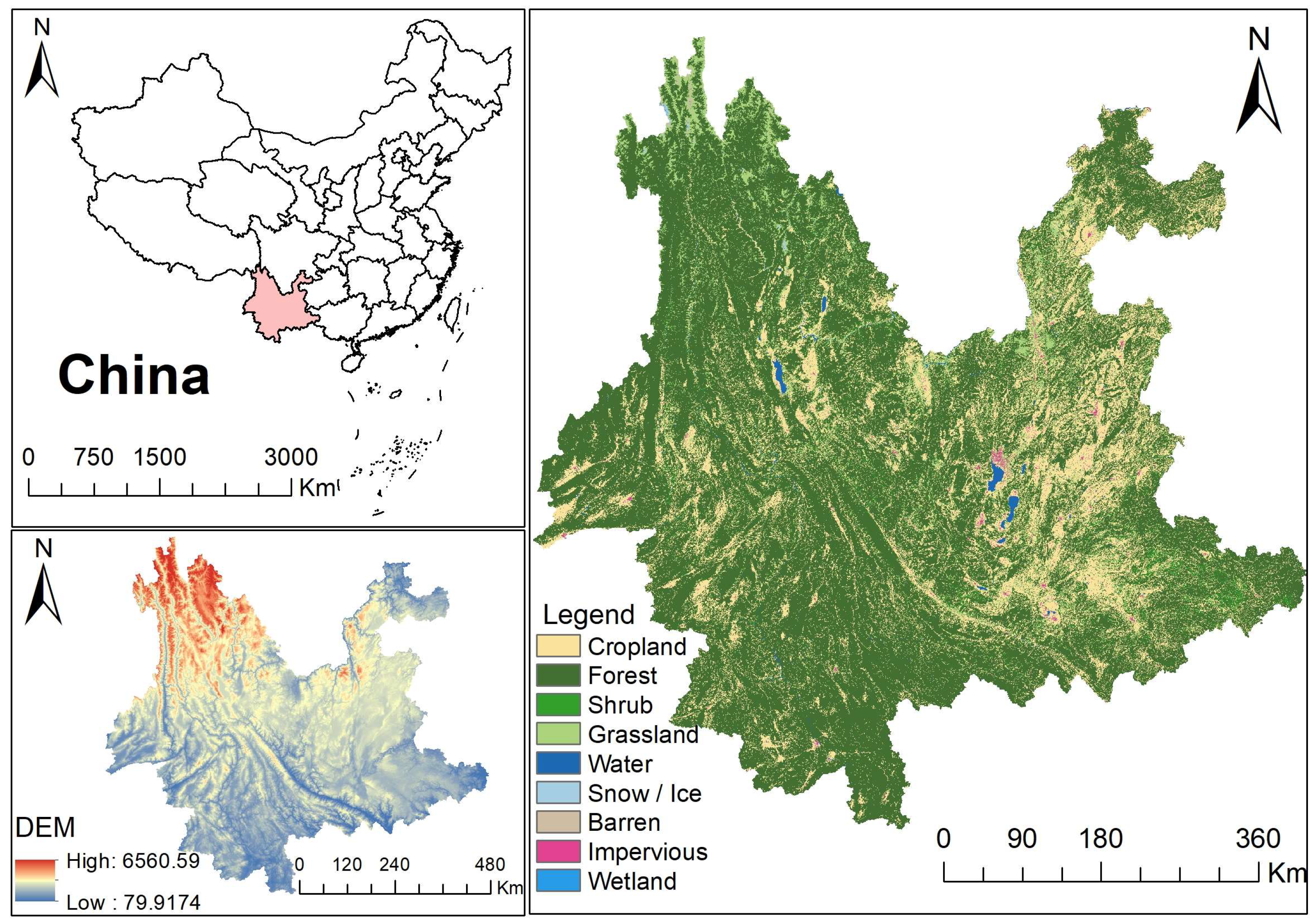
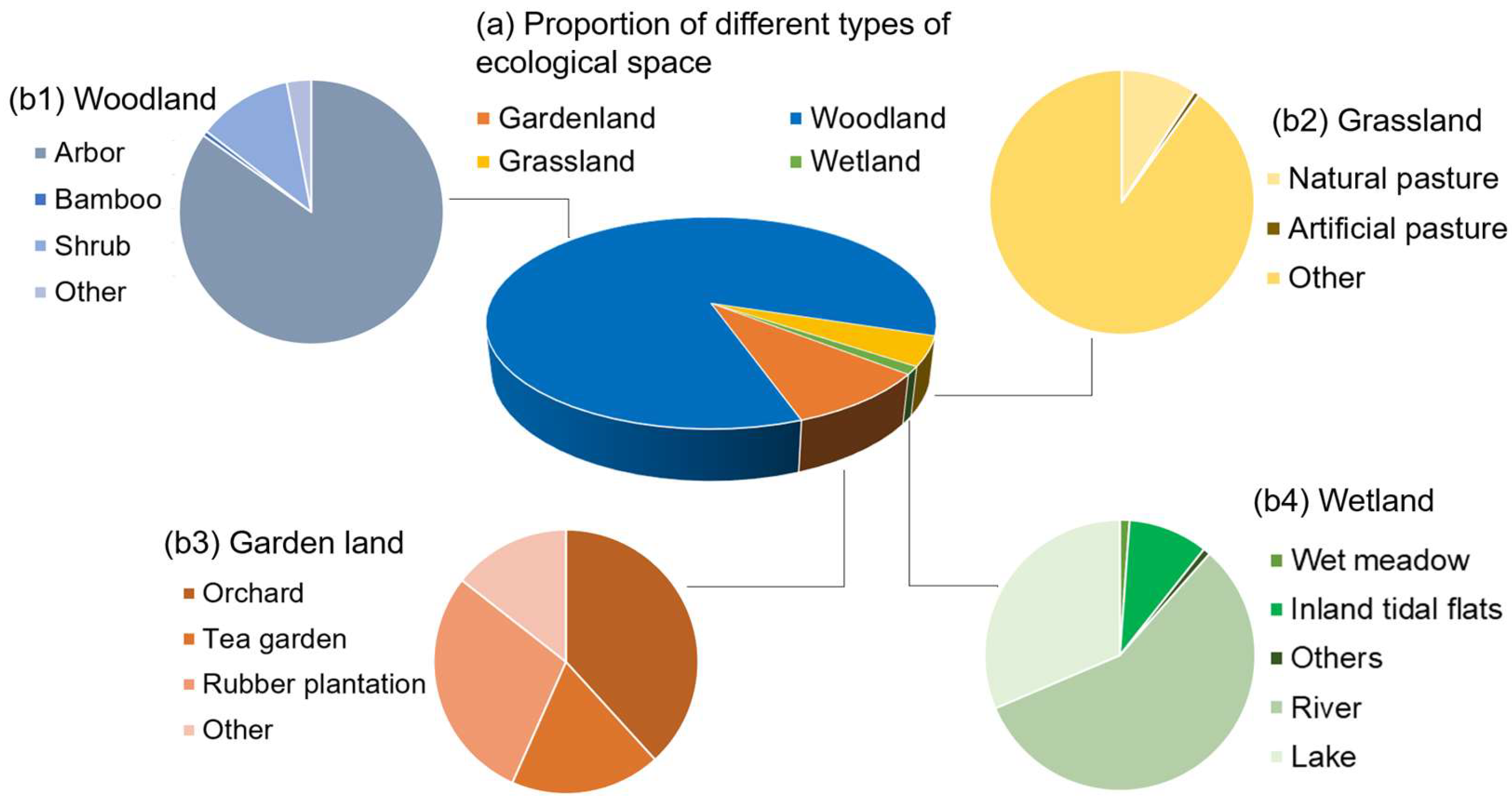


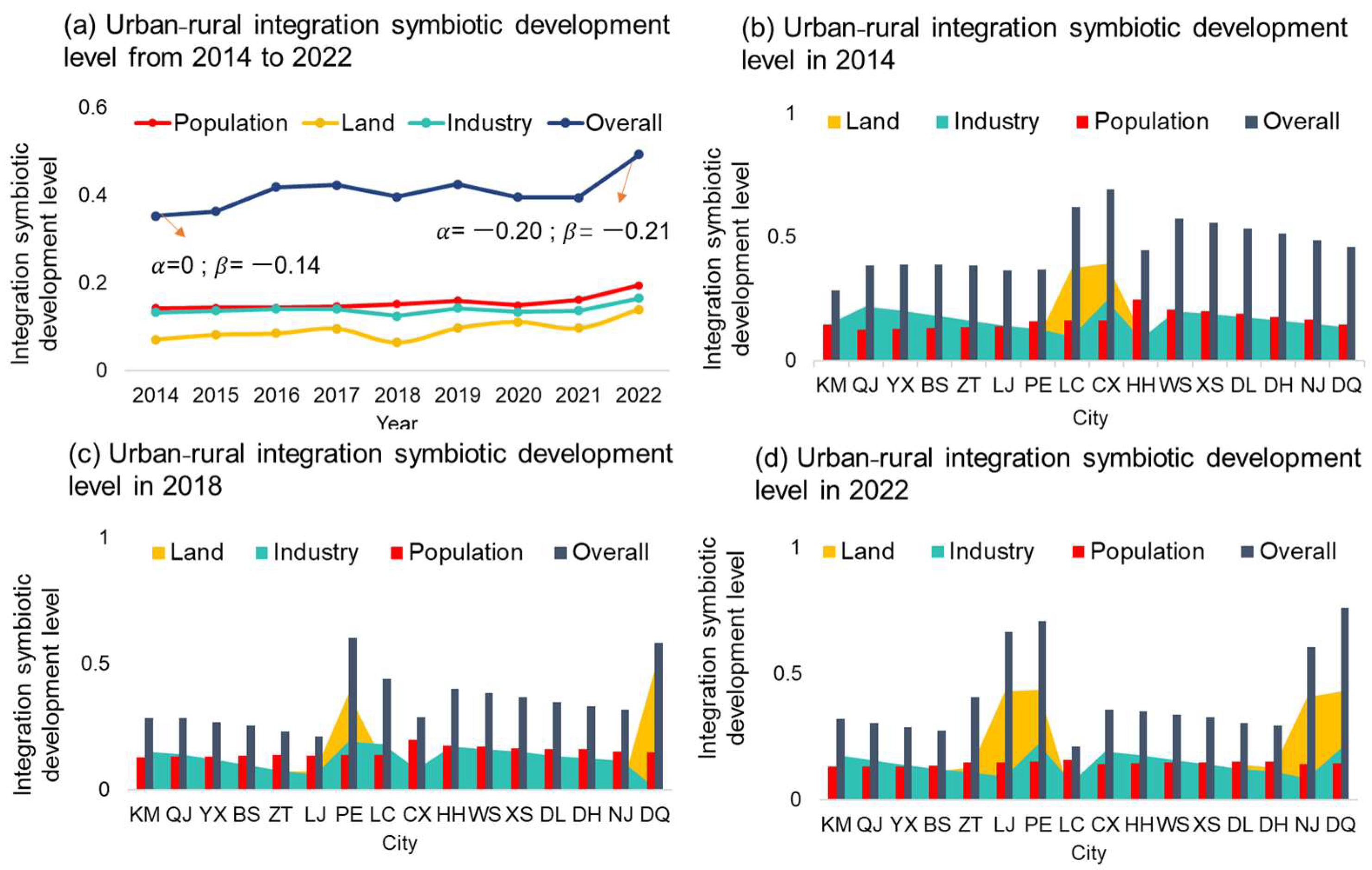

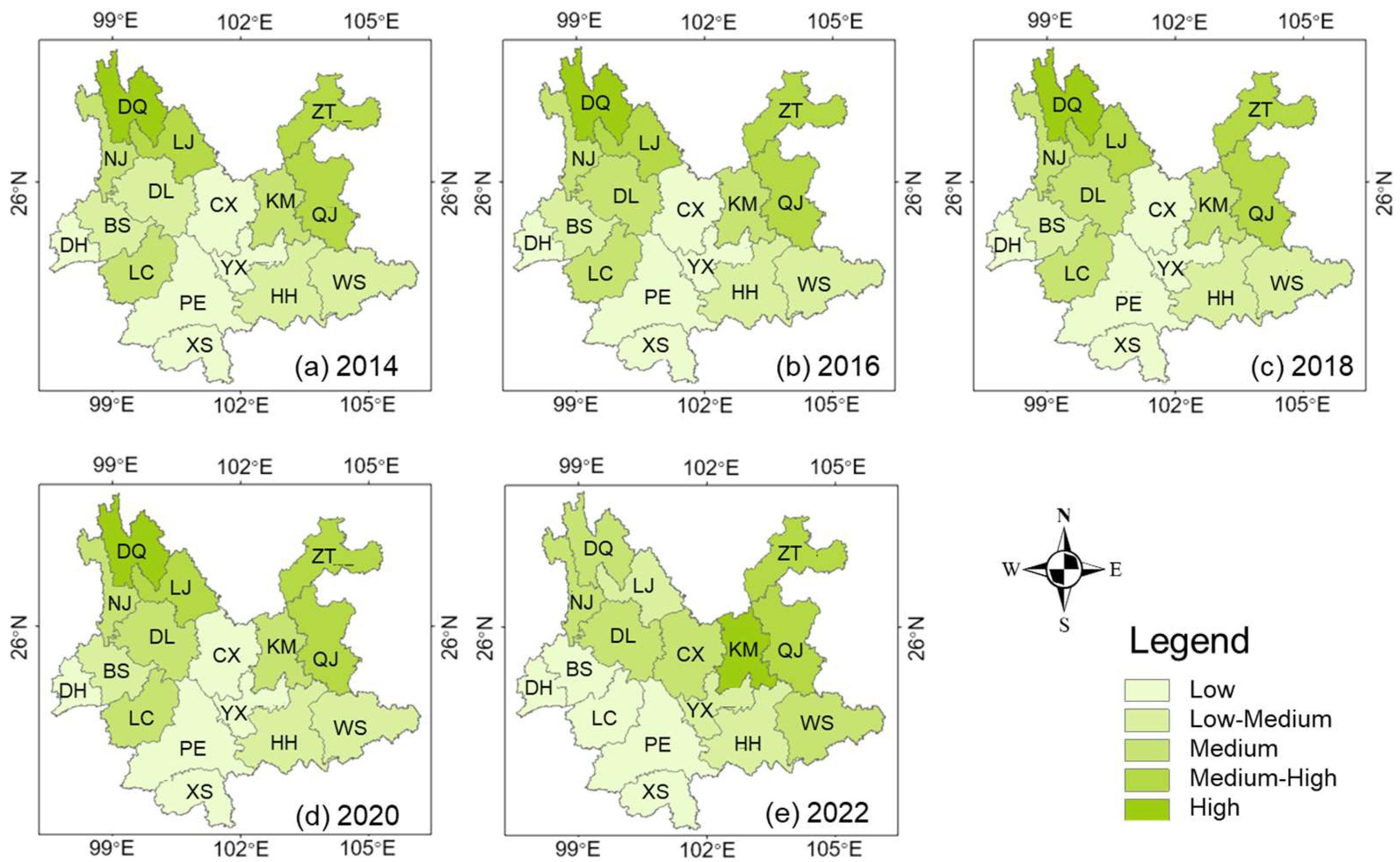


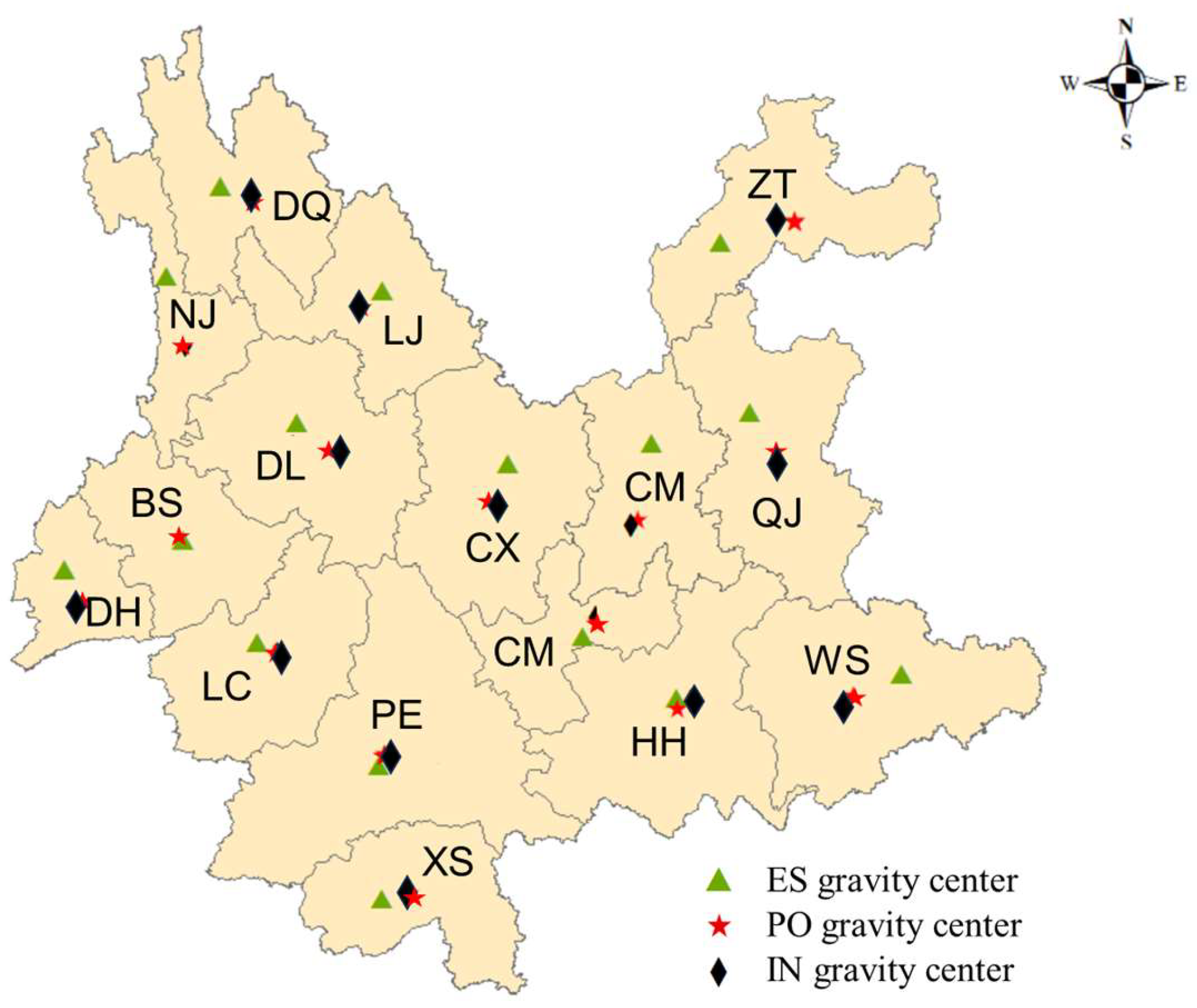
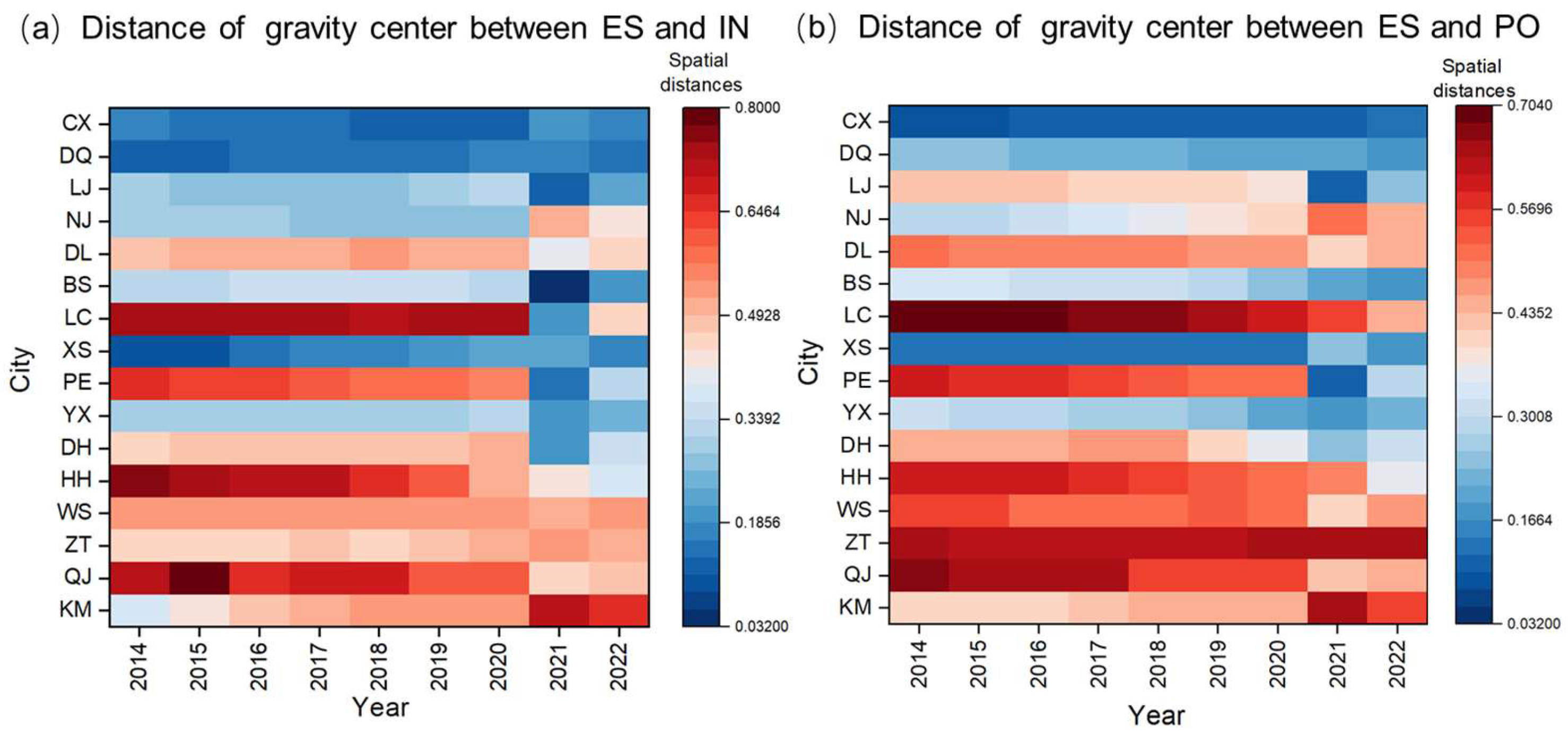
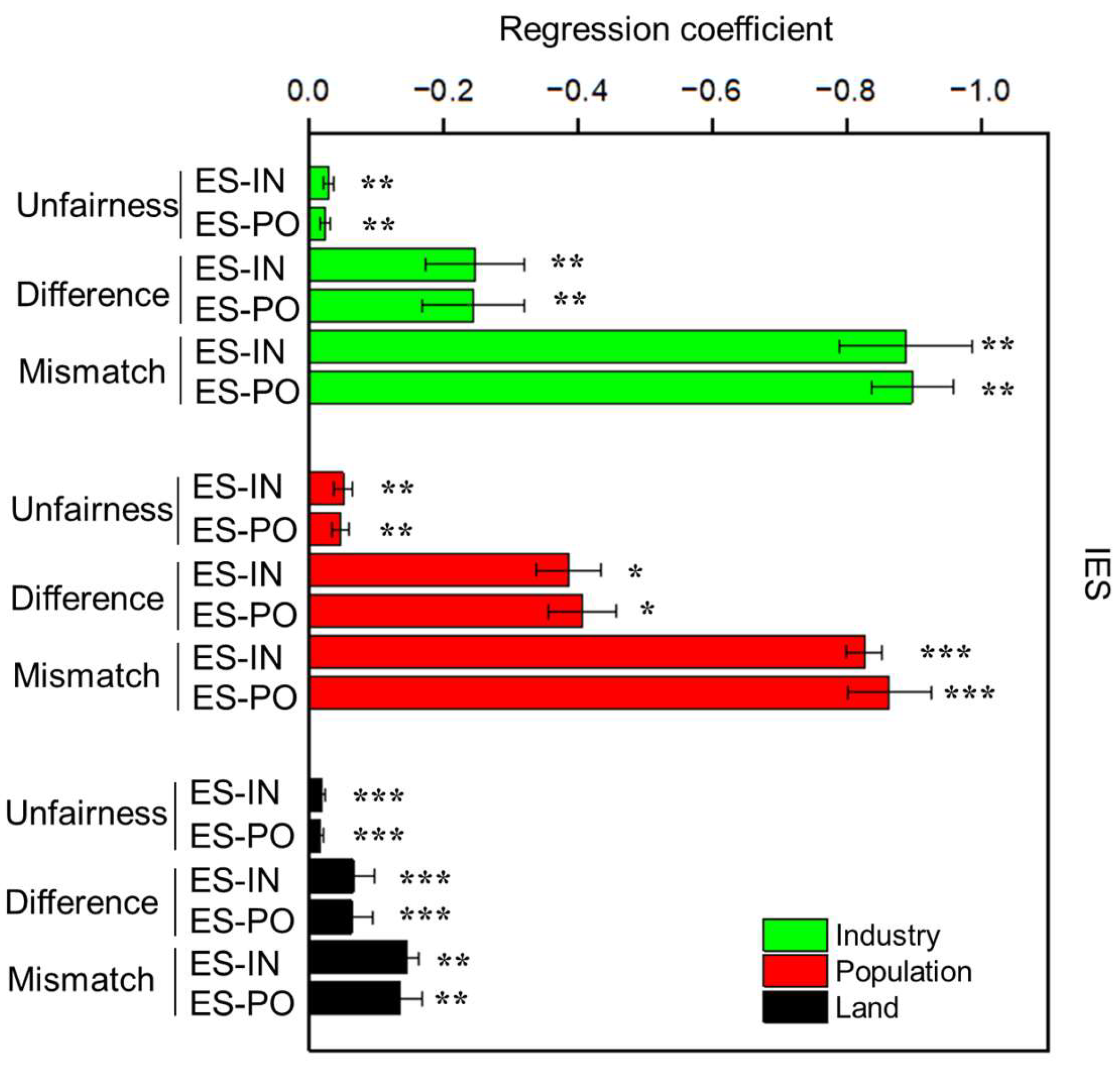
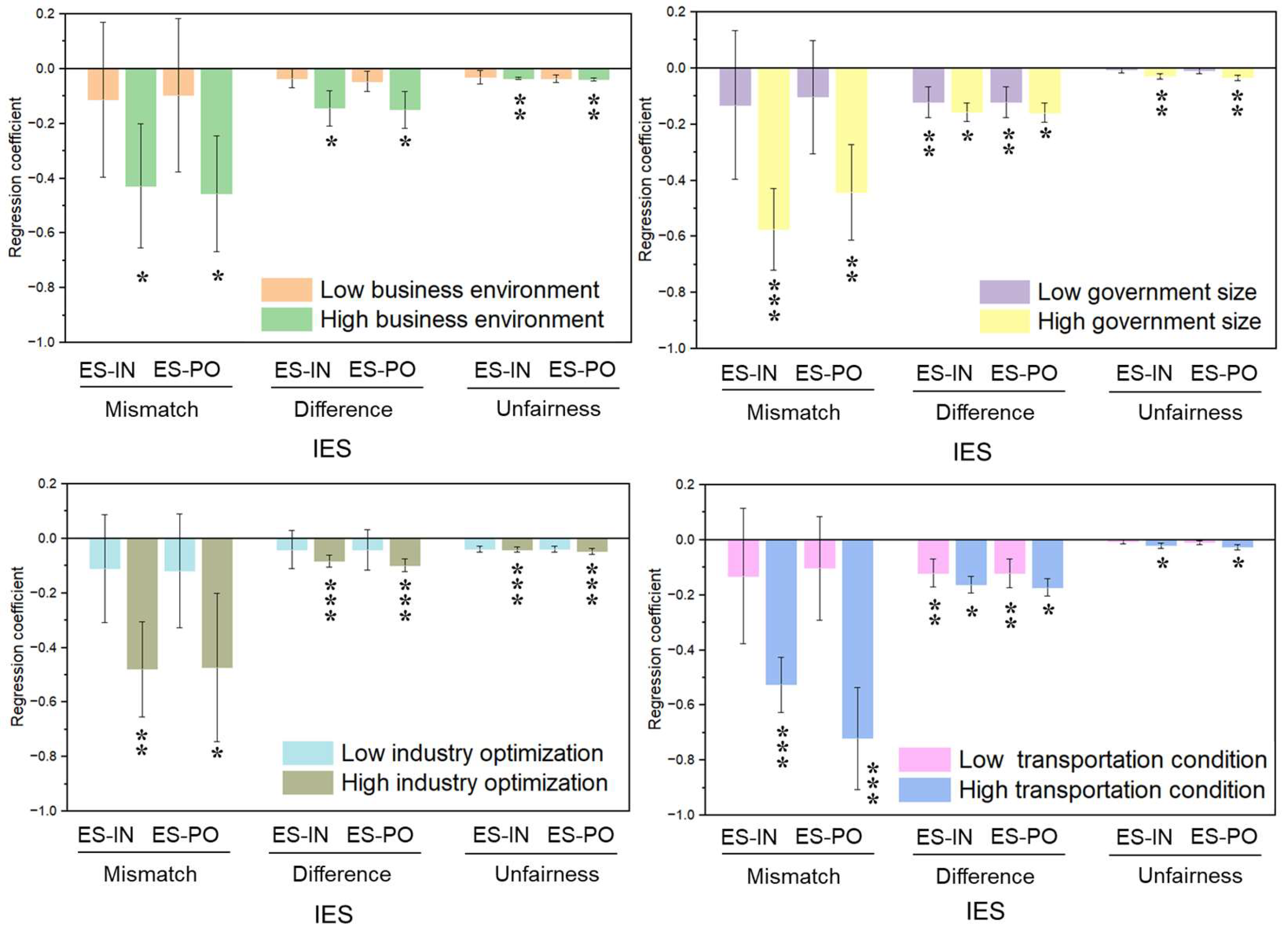
| Target | First Indicator Layer | Second Indicator Layer | |
|---|---|---|---|
| Urban | Rural | ||
| Urban–rural integration symbiotic development level (URI) | Population | Proportion of permanent urban residents (+) | Proportion of permanent rural residents (+) |
| Proportion of employed workers in urban units (+) | Proportion of employed workers in rural units (+) | ||
| Minimum subsistence allowance for urban residents (+) | Minimum subsistence allowance for rural residents (+) | ||
| Land | Proportion of urban construction land scale (+) | Proportion of rural settlement scale (+) | |
| Proportion of non-agricultural land scale (+) | Proportion of agricultural land scale (+) | ||
| Industry | Proportion of output value of secondary and tertiary industries (+) | Proportion of output value of primary industry (+) | |
| Urban per capita disposable income (+) | Rural per capita disposable income (+) | ||
| Range | Hierarchy |
|---|---|
| (0, 0.2) | Absolute average |
| [0.2, 0.3) | Relatively average |
| [0.3, 0.4) | More reasonable |
| [0.4, 0.5) | Large gap |
| [0.5, 1) | Wide gap |
| Variable | Description of Variables | ||
|---|---|---|---|
| Independent variable | Urban–rural integration symbiotic | Urban–rural integration symbiotic development level | |
| Dependent variable | Inequity in ecological space (IES) | Unfairness | Gini coefficient |
| Difference | Theil index | ||
| Mismatch | Distance of gravity center | ||
| Control variable | Government size | Government public budget expenditure/GDP | |
| Financial development | Year-end loan balance/GDP | ||
| Structure of industry | Proportion of secondary and tertiary industries | ||
| Business environment | Total import and export volume/GDP | ||
| Transportation condition | Road area per capita | ||
| Range | Level | |
|---|---|---|
| ES-IN Differences | ES-PO Differences | |
| (0.001, 0.002] | (0.001, 0.002] | Low |
| (0.002, 0.011] | (0.002, 0.009] | Low–Medium |
| (0.011, 0.014] | (0.009, 0.018] | Medium |
| (0.014, 0.032] | (0.018, 0.031] | Medium–High |
| (0.032, 0.068] | (0.031, 0.052] | High |
| Variable | (1) | (2) | (3) | (4) | (5) | (6) |
|---|---|---|---|---|---|---|
| Unfairness | Difference | Mismatch | ||||
| ES-IN | ES-PO | ES-IN | ES-PO | ES-IN | ES-PO | |
| URI | −0.021 *** | −0.026 *** | −0.047 ** | −0.048 ** | −0.321 * | −0.310 * |
| (0.006) | (0.007) | (0.019) | (0.020) | (0.166) | (0.137) | |
| Government scale | −0.000 ** | −0.000 ** | 0.003 *** | 0.003 *** | 0.003 | 0.001 |
| (0.000) | (0.000) | (0.000) | (0.000) | (0.002) | (0.002) | |
| Financial development | −0.000 ** | −0.000 ** | −0.000 | −0.000 | −0.002 *** | −0.002 *** |
| (0.000) | (0.000) | (0.000) | (0.000) | (0.000) | (0.000) | |
| Business environment | 0.000 * | 0.001 * | −0.003 *** | −0.003 *** | −0.005 ** | 0.004 * |
| (0.000) | (0.000) | (0.000) | (0.000) | (0.002) | (0.002) | |
| Innovation level | −0.000 | −0.000 | 0.029 *** | 0.028 *** | 0.225 ** | 0.164 ** |
| (0.002) | (0.002) | (0.008) | (0.008) | (0.077) | (0.066) | |
| Transportation condition | −0.000 *** | −0.000 *** | 0.000 | 0.000 | 0.000 | 0.000 ** |
| (0.000) | (0.000) | (0.000) | (0.000) | (0.000) | (0.000) | |
| Constant | 0.041 *** | 0.049 *** | −0.137 *** | −0.137 *** | −0.096 | 0.190 |
| (0.005) | (0.006) | (0.033) | (0.034) | (0.220) | (0.195) | |
| Time fixed effect | Yes | Yes | Yes | Yes | Yes | Yes |
| Individual fixed effects | Yes | Yes | Yes | Yes | Yes | Yes |
| N | 144 | 144 | 144 | 144 | 144 | 144 |
| R2 | 0.398 | 0.394 | 0.373 | 0.380 | 0.449 | 0.478 |
Disclaimer/Publisher’s Note: The statements, opinions and data contained in all publications are solely those of the individual author(s) and contributor(s) and not of MDPI and/or the editor(s). MDPI and/or the editor(s) disclaim responsibility for any injury to people or property resulting from any ideas, methods, instructions or products referred to in the content. |
© 2025 by the authors. Licensee MDPI, Basel, Switzerland. This article is an open access article distributed under the terms and conditions of the Creative Commons Attribution (CC BY) license (https://creativecommons.org/licenses/by/4.0/).
Share and Cite
An, X.; Meng, L.; Zeng, X.; Ma, L. How Urban–Rural Integration Symbiosis Can Ameliorate the Socioeconomic Inequity in Ecological Space: Evidence from Yunnan, China. Sustainability 2025, 17, 2895. https://doi.org/10.3390/su17072895
An X, Meng L, Zeng X, Ma L. How Urban–Rural Integration Symbiosis Can Ameliorate the Socioeconomic Inequity in Ecological Space: Evidence from Yunnan, China. Sustainability. 2025; 17(7):2895. https://doi.org/10.3390/su17072895
Chicago/Turabian StyleAn, Xianjuan, Lijun Meng, Xueting Zeng, and Lixuan Ma. 2025. "How Urban–Rural Integration Symbiosis Can Ameliorate the Socioeconomic Inequity in Ecological Space: Evidence from Yunnan, China" Sustainability 17, no. 7: 2895. https://doi.org/10.3390/su17072895
APA StyleAn, X., Meng, L., Zeng, X., & Ma, L. (2025). How Urban–Rural Integration Symbiosis Can Ameliorate the Socioeconomic Inequity in Ecological Space: Evidence from Yunnan, China. Sustainability, 17(7), 2895. https://doi.org/10.3390/su17072895







